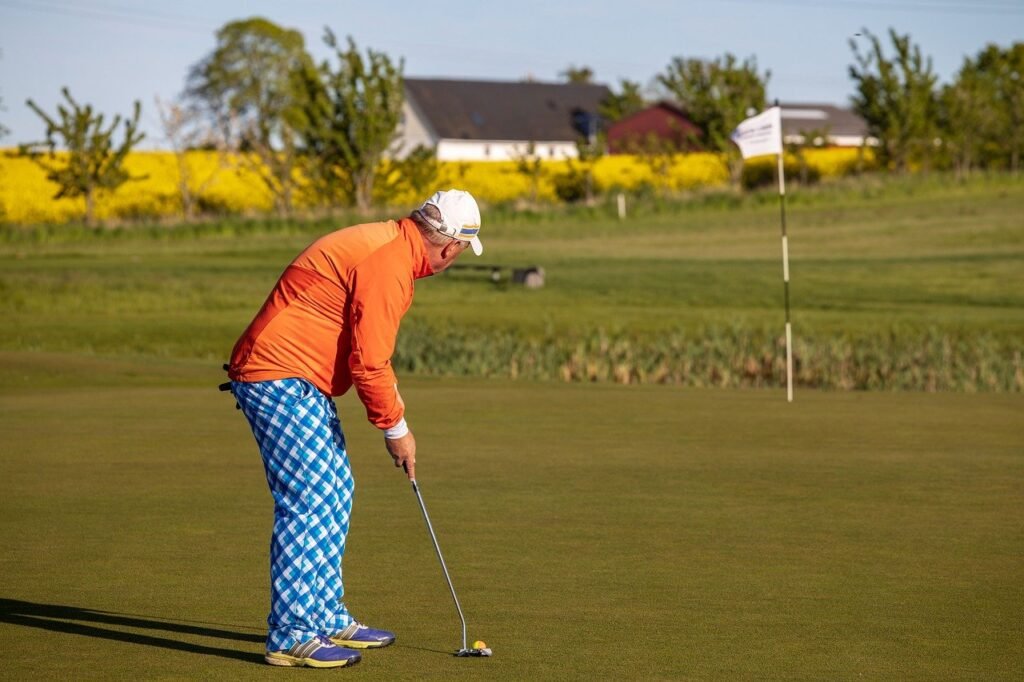Here’s an overview:
- Introduction: Understanding the Impact of Swaying and How to Stop Swaying in the Golf Swing
- The Foundation: Setting Up a Stable Stance
- Mastering the Art of Balance: Drills for a Steadier Swing
- Core Strength: The Key to Minimizing Sway
- Rhythm and Tempo: Timing Your Swing to Reduce Lateral Movement
- Visual Cues: How to Use Reference Points Throughout Your Swing
- Implementing Swing Thoughts: Mental Tricks to Prevent Sway
- Proper Weight Transfer: Learning the Dynamics of Movement
- Kinetic Chain Alignment: Ensuring Your Body Works Together
- Practice Makes Perfect: Creating a Consistent Routine
- Video Analysis: Using Technology to Identify and Fix Sway
- Conclusion: Putting It All Together for a Sway-Free Swing
Introduction: Understanding the Impact of Swaying and How to Stop Swaying in the Golf Swing
In the world of golf, mastering the art of the swing is a testament to a player’s dedication and proficiency. However, many golfers, from enthusiastic beginners to seasoned players, occasionally find themselves battling with the tendency to sway. Swaying, the lateral movement of the body during the swing, can wreak havoc on the consistency and accuracy of your shots.
The impact of swaying is more profound than it might initially seem:
- Accuracy: When you sway, you alter the dynamics of your swing path. This movement can cause the clubface to strike the ball in an unpredicted manner leading to errant shots.
- Power: Swaying often results in a loss of power. The golf swing relies on the efficient transfer of energy, and swaying disrupts this transfer, weakening shot strength.
- Balance: One of the critical components of a solid swing is maintaining balance. Swaying compromises your stability, making it difficult to return the clubhead to the ball consistently.
Moreover, swaying strains the body in ways that can lead to discomfort or even injury. The act of swaying imposes additional stress on the hips, back, and knees, which could have long-term repercussions on a golfer’s health.
Confronting the tendency to sway isn’t just about correcting a fleeting flaw. It’s about ingraining a fluid, powerful, and consistent movement into your muscle memory. Perfecting your stance to stop swaying is akin to building a foundation for a house. Without a stable base, the integrity of the entire structure is compromised. Hence, addressing swaying is fundamental to elevating your golf game to new heights.
The Foundation: Setting Up a Stable Stance

Achieving a flawless golf swing starts with the basics, and at the core of those basics is your stance. Think of your stance as the foundation of a house; if it’s shaky, the entire structure – or in this case, your swing – is at risk.
To cultivate a stable stance, one must:
- Begin with your feet: Plant them shoulder-width apart, creating a balanced base that is neither too narrow nor too broad. This spacing is crucial as it allows for optimum balance and weight distribution throughout your swing.
- Check your foot alignment: Your feet should be parallel to the target line, with toes slightly flared out. This arrangement aids in a full range of motion during the backswing and follow-through.
- Bend at the hips, not the waist: By hinging from the hips, you promote a better posture. This not only helps in preventing a sway but also enhances rotational movement.
- Flex the knees: Keeping the knees slightly bent adds an athletic readiness to your stance. It’s a happy medium – too rigid and you’re immobile, too bent and you’ll struggle with balance.
- Distribute your weight evenly: Aim to balance your weight across the balls of your feet, the heels, and both your left and right sides evenly. As the swing progresses, your weight will shift, but starting from a balanced position is key.
- Keep the back straight: A straight, but not rigid, back will keep your spine aligned. This also contributes to a consistent swing plane.
- Relax the shoulders: Tension in the shoulders can lead to a restrictive swing. Let them drop naturally to keep the upper body relaxed.
- Grip with care: Your hands should hold the club firmly but without tension. Over-gripping can lead to a loss of fluidity and control.
Once your stance is set, it should feel comfortable and balanced. Spend time fine-tuning these elements, because a stable stance is a linchpin to eliminating sway and perfecting your swing. Remember, great shots begin before the club ever moves.
Mastering the Art of Balance: Drills for a Steadier Swing
Achieving a smooth, efficient golf swing is largely a matter of maintaining good balance. Golfers often struggle with swaying because they lose equilibrium during their backswing or downswing. Here are some drills that can help stabilize your stance and keep your swing steady:
- One-Legged Swings: Balance on one leg while taking practice swings. This drill forces you to stabilize your core and enhances balance in your swing. Switch between your right and left legs to build strength and steadiness on both sides.
- Foot-Together Drills: Practice swinging with your feet together. This position makes it more challenging to maintain balance, thus training your body to rely on proper swing mechanics rather than momentum.
- Swing with Resistance Bands: Attach a resistance band to a fixed point and to your golf club. The tension from the band during your swing will encourage a controlled, balanced motion.
- Head Against Wall Swings: Stand so that the side of your head is gently resting against a wall. Take practice swings without losing contact with the wall. This drill keeps your head steady and discourages lateral movement.
- Delayed Impact Drills: Slow down your swing, especially at the point of impact. A slower swing requires more control and encourages a balanced, deliberate motion.
- Toe-Tap Drill: During the backswing, lift your front foot’s heel and tap the toe gently on the ground. This motion helps stabilize your backswing and controls your weight transfer.
Regular practice of these drills will help embed the sensation of balance in your swing. Remember, the goal is not to eliminate movement but to control it, maintaining a steady flow from backswing to follow-through without unnecessary lateral shifts.
Core Strength: The Key to Minimizing Sway

Core strength plays a pivotal role in stabilizing the body throughout a golf swing. Swaying is a common issue where golfers shift laterally during their swing, often leading to inconsistent shots and strain. By focusing on the core—comprising the abdominal, lower back, hip, and glute muscles—golfers can drastically reduce sway and improve balance.
A robust core anchors the golfer, allowing the upper body to rotate around a stable base. This rotation is essential for power generation and control. Without adequate core stability, the temptation to compensate with excessive hip or shoulder movement can lead to sway.
To harness core strength for sway minimization, golfers can incorporate the following exercises into their routine:
- Planks: A staple for core conditioning, holding a plank strengthens the entire core region.
- Russian twists: This exercise targets the obliques, which are crucial for rotational control during the golf swing.
- Bird dogs: By promoting balance and core engagement, bird dogs can help build a stable swing foundation.
- Dead bugs: This move replicates the opposite arm and leg extension found in a powerful swing, reinforcing coordination and core strength.
Remember, engaging the core isn’t just about brute strength; it’s also about muscle activation and control. During the swing, actively ‘bracing’ the core provides the necessary support to keep the body centered and prevent lateral movement. It’s similar to prepping the core muscles prior to lifting a heavyweight.
Improving core strength isn’t an overnight fix, but with dedication and consistent training, golfers will notice less sway and more precision in their swing. The saying “Drive for show, putt for dough” emphasizes the flair of the long game, but solid core strength is the unsung hero in the golfer’s arsenal, essential for both power and finesse on the course.
Rhythm and Tempo: Timing Your Swing to Reduce Lateral Movement
To hit the ball straight and with power, you must minimize lateral movement, often referred to as “swaying”. Swaying can throw off your balance, reduce the efficacy of your swing, and ultimately impact the trajectory and distance of your shot. Rhythm and tempo are key elements in ensuring that your swing stays on a stable, vertical axis, helping to eliminate unnecessary side-to-side motion.
When working on your golf swing, focus on the following aspects of rhythm and tempo:
- Start with the Basics: Begin with slow, smooth swings. Pay attention to each stage of your swing and avoid the temptation to rush. Slowing down helps you feel the swing’s components and engrain the right movement.
- Consistent Pace: Your backswing and downswing should be at a consistent pace. Avoid the common mistake of a quick backswing followed by a rushed downswing. A uniform tempo throughout promotes balance and control.
- Swing to a Beat: Some golfers find it useful to swing to a mental metronome or an actual rhythmic beat. It might be a count like “one-and-two” where “one” is the takeaway, “and” is the top of the swing, and “two” is the impact with the ball. This can help maintain a steady tempo.
- Pause at the Top: Introducing a slight pause at the top of your swing before starting your downswing can help you stay synced and avoid the urge to lead with your body, which can cause sway.
Implementing a disciplined focus on your swing’s rhythm and tempo can significantly reduce lateral movement. Over time, this approach will create a more efficient and powerful swing, letting the club do more of the work and your body less of the chasing. Practice patience and be conscious of timing; it can make all the difference in perfecting your stance and keeping you from swaying.
Visual Cues: How to Use Reference Points Throughout Your Swing

When perfecting your stance to eliminate swaying in golf, it’s crucial to incorporate visual cues and reference points into your swing routine. These serve as guideposts, assisting in maintaining stability from setup to follow-through.
- Setup Position: Before swinging, choose a fixed point on the ground, like a discolored patch of grass or a leaf, aligned with the ball. This gives a visual reminder to keep your head over this spot, reducing the tendency to sway.
- Backswing Checkpoint: At the top of your backswing, picture a vertical line running up from the ball. Your head should remain on the ‘safe’ side of this line. If you notice it crosses the line, you’ve swayed. This imaginary line acts as a powerful deterrent against excessive lateral movement.
- Impact Zone: As you move into the downswing, envision a line perpendicular to your target line just behind the ball. The goal is to have your leading hip reach this point at impact. It encourages a forward shift rather than a lateral sway and positions you for more powerful contact.
- Follow-through: Identify a spot in the distance, directly in line with your target. As you complete your swing, your chest should face this spot. It’s a simple but effective way to ensure you’re rotating correctly around your spine without sliding sideways.
Remember, you’re programming your body to swing within a virtual frame composed of these reference points. With repetition, your muscle memory will help you naturally stay within the ‘lines’, reducing swaying and improving the consistency and power of your swings. Keep it light-hearted and enjoyable—turning these reference cues into a game can make practice sessions both effective and fun.
Implementing Swing Thoughts: Mental Tricks to Prevent Sway
Golfers often grapple with the pesky habit of swaying during their swing. It’s a movement that can throw off balance and accuracy, but with a few mental tricks, it’s possible to prevent sway and perfect your stance.
First up, imagine your head is in a bubble that can’t be popped. Throughout your swing, picture that bubble remaining intact – no tilting or bobbing allowed. This visualization anchors your head and, by extension, your body, preventing unwanted lateral movement.
Next, consider your feet as the roots of a tree, grounded and stable. As you swing, sense the connection between your feet and the ground, reinforcing the idea of stability. It’s almost like you’re growing roots into the turf, creating an unwavering foundation.
Another useful swing thought is to ‘swing in a barrel.’ Picture a barrel surrounding your upper body. To maintain a steady swing, avoid touching the sides of the barrel. This mental image helps you stay centered and avoid swaying outward as you swing.
Finally, don’t forget the power of a preset drill. Before you take your swing, shift your weight to your leading leg as if completing the swing. This conditions your body to the correct finish position and reminds your muscles to resist the urge to sway.
By integrating these mental tricks into your practice, you’ll be unlocking a more stable and powerful swing that keeps sway at bay. Remember, it’s all about the mind-game. Keep your focus, and don’t let sway sweep away your next shot.
Proper Weight Transfer: Learning the Dynamics of Movement

Mastering the art of weight transfer is essential for any golfer looking to eliminate sway in their swing. It’s all about understanding the rhythm and flow of your body’s motion as you transition from backswing to downswing.
When you set up for your swing, your weight should be evenly distributed between your two feet. As you coil back, a controlled shift allows approximately 60-70% of your weight to move to the inside of your back foot. This sets the stage for a powerful and balanced downswing.
Here’s how you can enhance your weight transfer:
- Initiate the backswing with a smooth takeaway, ensuring your front shoulder moves under your chin, promoting a proper weight shift.
- Focus on your hip rotation rather than the lateral movement. Your back hip should rotate, not sway.
- During the downswing, drive your weight toward the target, rolling from the inside of your back foot to the front foot.
- Ensure your front hip is clearing out of the way to allow a clean transfer of weight. This will also help increase swing speed and power.
- Practice drills that emphasize staying grounded on your backswing, such as the ‘foot against the wall’ or ‘weighted step-through’ drills.
Visualizing your lower body as the foundation of a pendulum can also aid in maintaining stability. The legs and hips are the base that must remain steady as the arms and club swing. By focusing on the dynamics of your lower body, you ensure a rock-solid stance that will help eradicate any tendency to sway.
It’s also important to remember that a proper weight transfer does not mean over-exaggerating the movement. A subtle yet effective transfer is what’s needed for a fluid swing that stays on plane. Golfers should always look for that sweet spot where control meets power. With diligence and practice, the dynamics of movement can be honed to perfection.
Kinetic Chain Alignment: Ensuring Your Body Works Together

When a golfer takes a swing, it’s not just about brute strength or the precision of the strike. It’s about the harmony of movement within the body, often referred to as the kinetic chain alignment. This concept emphasizes the importance of each body part working in synchronization during the golf swing. By aligning the kinetic chain properly, a golfer can reduce swaying and enhance the effectiveness of their stance.
Think of the kinetic chain like a well-rehearsed orchestra. Each musician—or in this case, body part—must play their part at the right time to create a beautiful symphony—or a perfect swing. Here’s how to ensure the body parts are working together:
- Start with the feet, planted firmly on the ground, providing a stable base.
- The knees should be slightly bent, ready to transfer weight smoothly.
- Hips and core are engaged, providing the rotation necessary for power.
- Shoulders must turn in coordination with the hips to maintain a square clubface.
- Finally, arms and wrists should follow through, completing the elegant motion of the swing.
A misalignment at any point can disrupt this sequence and cause sway. For instance, if the hips rotate too quickly or too slowly compared to the shoulders, the golfer’s balance is thrown off, leading to an ineffective swing and the dreaded sway.
To troubleshoot kinetic chain issues, golfers can work with instructors who employ drills focusing on isolated parts of the swing, gradually integrating them into a fluid motion. Regular practice of these principles can make the difference, ensuring each swing is delivered with the grace and power of an ensemble in perfect tune.
Practice Makes Perfect: Creating a Consistent Routine
For any golfer looking to eliminate the dreaded sway from their swing, consistency is key. Building a reliable routine can transform your performance, and it starts with practicing the fundamentals regularly. Here’s a breakdown on how to create such a routine:
- Commit to Daily Drills: Choose a set of drills specifically designed to combat sway in your swing. Incorporate these into a daily practice schedule. Even 15 minutes a day can lead to significant improvement.
- Work on Your Balance: Balance exercises often help in stabilizing your swing. Standing on one leg while practicing your swing or using a balance board can increase your body awareness and control.
- Use Visual Aids: Mirrors can be your best friend. Observing your stance, swing, and the resulting balance in a full-length mirror provides instant feedback.
- Incorporate Video Analysis: Record your swing to review your progress and identify consistent flaws that could be causing your sway.
- Seek Expert Advice: Regular sessions with a golf instructor ensure that any adjustments to your swing are correctly implemented. This professional oversight helps to solidify good habits.
- Focus on Your Feet: Pay special attention to the placement and movement of your feet. Use foot alignment mats or similar tools to help establish a solid, sway-free base.
Remember, the goal isn’t to practice until you get it right; it’s to practice until you can’t get it wrong. Establishing a strong, consistent routine enables muscle memory to take over, bypassing the conscious thought that often leads to errors like swaying. So, stay patient and persistent. The absence of sway in your swing will come as a result of diligent practice and a rock-solid routine.
Video Analysis: Using Technology to Identify and Fix Sway
In the quest for the perfect golf swing, video analysis has emerged as a highly effective tool for identifying and correcting sway. Picture it: golfers standing before a camera, executing their swings with precision—or so they presume—until playback reveals the inconvenient truth.
Capturing the Swing – With high-definition cameras and smartphones, golfers can now record their swings from multiple angles. It’s like having an omnipresent coach, with the added advantage of being able to review each swing in slow motion.
Identifying the Sway – During playback, the sway becomes apparent as the golfer’s body drifts away from the initial position, shifting weight incorrectly. The key is to focus on the lower body stability and how the hips rotate without lateral movement.
Drawing Conclusions – Many video analysis software allow users to draw lines and circles on the playback to highlight the key areas. By tracing the head, spine, and base line, one can easily visualize the deviation caused by sway.
Implementing Fixes – Once identified, the video becomes a powerful feedback loop. Drills and exercises to improve core stability and hip mobility can be practiced, with subsequent swings recorded to measure improvement.
Advantages of Video Analysis:
- Immediate Feedback: Video doesn’t lie. Golfers can see the flaw in real-time and make corrections accordingly.
- Objective Assessment: Personal biases are removed. The camera captures the pure mechanics of the swing.
- Progress Tracking: Over time, golfers can save and compare videos to track improvement and see the effects of different adjustments.
Video analysis turns the invisible visible. By harnessing technology, golfers gain the insight needed to ground their stance and finally say farewell to sway.
Conclusion: Putting It All Together for a Sway-Free Swing

When tackling the common issue of swaying in your golf swing, remember that perfecting your stance is an integral part. Eliminating sway isn’t about rigidly fixing one piece; it’s a symphony of well-coordinated movements and checks.
- First off, establish a solid base. Plant your feet as if they’ve got roots reaching deep into the ground. This foundation will help you resist the temptation to move laterally.
- Visual cues are your friends. Picture a barrier on either side that keeps your swing tight and centered. Some golfers even imagine their head enclosed in a glass box to stabilize posture.
- Core strength can’t be underestimated. Work on enhancing muscle stability; a strong core is like the anchor stopping your boat from drifting.
- Don’t just swing; think rhythm and balance. Your body should move like a well-oiled machine, with each part coming alive at just the right moment.
- Practice with purpose. Use drills tailored to reinforce staying put. Try the one-foot or alignment stick approaches to physically challenge any sway.
- Finally, feedback is essential. Track your progress either through a coach, recording yourself, or using swing analysis software.
Once these pieces fall into place, you’ll find your swing feeling more natural and powerful, all without the extra swaying movement. It’s a game of inches, and removing the sway could be the difference between a good shot and a perfect one. Keep these points in check, and enjoy the satisfaction that comes with that silky smooth, sway-free swing.
Discussing how to stop swaying in the golf swing on your blog? It might be beneficial to explore different swing techniques, such as the one-plane golf swing, which promotes stability and efficiency in movement. This method could help your readers understand the mechanics behind minimizing sway. For a comprehensive breakdown of what a one-plane golf swing entails and how it might benefit your swing stability, check out the detailed guide at What Is a One-Plane Golf Swing.
